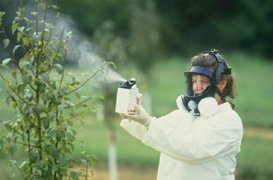Label Review Training: Module 3: Special Issues, Page 12
Section 3: What are directions for use?
Standard Elements of Directions for Use
As mentioned briefly in Module 2, the following elements should appear in the directions for use section of the label in the following order:
- “Directions for Use” heading
Headings such as “General Directions,” “Use Directions,” “Recommendations for Use,” “Recommended Uses,” “How to Use,” or any other similar wording are not acceptable. - Use classification statement (if applicable)
If a product is classified as restricted use, the label must bear the phrase “Restricted Use Pesticide” directly under the heading “Directions for Use.” - Misuse and related statements
All experimental use permits and registered pesticides, including all end-use and manufacturing use products, must bear labeling that has the following misuse statement: "It is a violation of federal law to use this product in a manner inconsistent with its labeling."
Other statements relating to misuse are acceptable for residential/household-use products. These additional statements can appear on the label following the required general misuse statement mentioned above. - Worker Protection Standard (WPS) requirements (if applicable)

WPS regulations require certain statements on the labeling of all pesticide products subject to WPS. Required WPS statements should appear after the general misuse statement under the heading “Agricultural Use Requirements.” WPS statements generally include the subheadings:- “General Statements”
- “Restricted Entry Interval”
- “Notification to Workers Statements”
- “Non-Agricultural Use Requirements”
The following general statements must appear on all WPS labels near the beginning of the directions for use section of the labeling under the heading “Agricultural Use Requirements.”- “Do not apply this product in a way that will contact workers or other persons, either directly or through drift. Only protected handlers may be in the area during application.”
- “For any requirements specific to your state or tribe, consult the state or tribal agency responsible for pesticide regulation.”
- “[General] Instructions and Information” subheading (if applicable)
Labels may include a section that explains how the product works and provides information that is applicable to all the use sites and pests listed on the label. The word “general” is not required, and EPA reviewers should discourage its use because it may invite registrants to mix recommendations together with directions intended to be mandatory statements. It is, however, common on older labels and not prohibited. - Use restrictions (if applicable)
Use restrictions include general, or non-site-specific, precautions, restrictions, or limitations of the product. A use restriction may consist of an imperative sentence (practically any sentence that begins with a verb and ends in a period) or any other sentence that requires or forbids certain action. Use restrictions may also be phrased as requirements by using words such as “must,” “never,” and “always.” Use restrictions may include, but are not limited to, the following categories:- User restrictions.
- Rate restrictions or limitations.
- Site, pest, timing, weather, soil, and geographic restrictions.
- Equipment or application method restrictions.
- Miscellaneous precautions, such as staining and incompatibility with other products.
- Pre-harvest intervals or rotational crop restrictions (unless site-specific).
- Chemigation information (if applicable)
Review of labels for uses for agriculture, nurseries, golf courses, sod farms, or greenhouses should be conducted with reference to the guidance contained in Pesticide Registration (PR) Notice 87-1, unless the product is solely for residential use, direct injection into plants, or post-harvest application, or if it is applied as a gas or solid (pellets, tablets, granules, or dusts). Subject labels must either include labeling statements regarding chemigation contained in PR Notice 87-1 or the statement: “Do not apply this product through any type of irrigation system.”
Any product used on agricultural sites that may be applied by chemigation should contain information such as the following:- Types of irrigation systems to be used.
- Consequences of improper chemigation.
- To whom questions about chemigation can be directed.
- Warnings against connecting irrigation equipment to public water supplies without safety mechanisms.
- Personnel required for adjustment of chemigation equipment.
- Statements required for Toxicity Category I products.
Note that PR Notice 87-1 contains the complete wording of all the chemigation text categories indicated above. Check relevant reregistration eligibility decision (RED) documents or any chemigation text specific to the active ingredient(s) in the product under review. - Spray drift labeling (if applicable)
Generic label language for spray drift prevention is still pending in a draft PR notice, as of January 2010. In the meantime, EPA is developing spray drift management label language on a case-by-case basis. Typically, risk from potential spray drift, based on the use patterns for any given product, will be identified in the risk assessment. The label reviewer should check the relevant RED or reregistration documents for required spray drift language, as well as work with the risk assessors to craft appropriate spray drift risk-mitigating label language. - Endangered species label statement (if applicable)
To address Endangered Species Act and FIFRA obligations, some products are required to carry a statement informing the user of potential risk to endangered species. These products must include the following statement at the beginning of the directions for use section:
“ENDANGERED SPECIES PROTECTION REQUIREMENTS
This product may have effects on endangered species. When using this product, you must follow the measures contained in the Endangered Species Protection Bulletin for the county in which you are applying the product. To obtain Bulletins, no more than six months before using this product, consult https://www.epa.gov/endangered-species or call 1-844-447-3813. You must use the Bulletin valid for the month in which you will apply the product.”
Page 12 of 43
Previous Page Next Page
